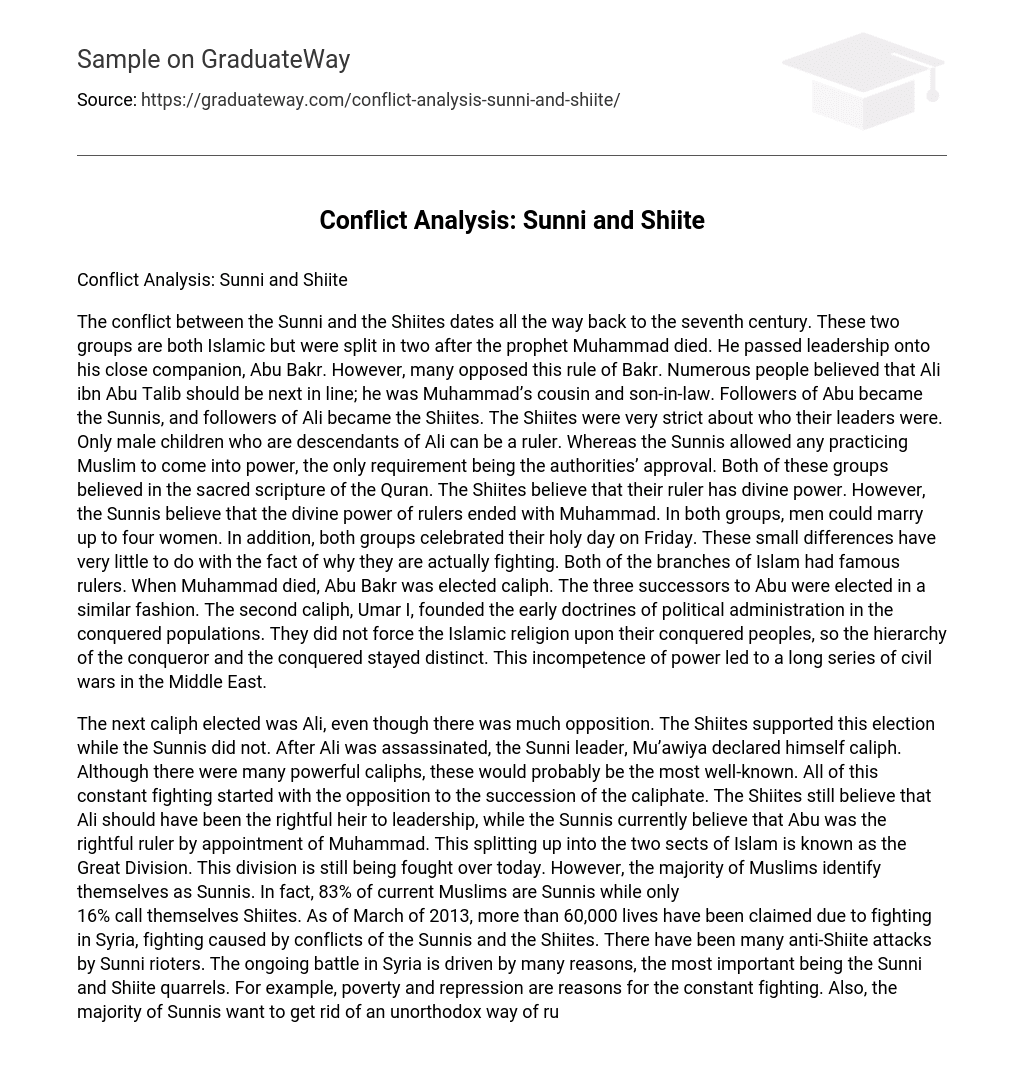The conflict between the Sunni and the Shiites dates all the way back to the seventh century. These two groups are both Islamic but were split in two after the prophet Muhammad died. He passed leadership onto his close companion, Abu Bakr. However, many opposed this rule of Bakr. Numerous people believed that Ali ibn Abu Talib should be next in line; he was Muhammad’s cousin and son-in-law. Followers of Abu became the Sunnis, and followers of Ali became the Shiites. The Shiites were very strict about who their leaders were. Only male children who are descendants of Ali can be a ruler. Whereas the Sunnis allowed any practicing Muslim to come into power, the only requirement being the authorities’ approval. Both of these groups believed in the sacred scripture of the Quran. The Shiites believe that their ruler has divine power. However, the Sunnis believe that the divine power of rulers ended with Muhammad. In both groups, men could marry up to four women. In addition, both groups celebrated their holy day on Friday. These small differences have very little to do with the fact of why they are actually fighting. Both of the branches of Islam had famous rulers. When Muhammad died, Abu Bakr was elected caliph. The three successors to Abu were elected in a similar fashion. The second caliph, Umar I, founded the early doctrines of political administration in the conquered populations. They did not force the Islamic religion upon their conquered peoples, so the hierarchy of the conqueror and the conquered stayed distinct. This incompetence of power led to a long series of civil wars in the Middle East.
The next caliph elected was Ali, even though there was much opposition. The Shiites supported this election while the Sunnis did not. After Ali was assassinated, the Sunni leader, Mu’awiya declared himself caliph. Although there were many powerful caliphs, these would probably be the most well-known. All of this constant fighting started with the opposition to the succession of the caliphate. The Shiites still believe that Ali should have been the rightful heir to leadership, while the Sunnis currently believe that Abu was the rightful ruler by appointment of Muhammad. This splitting up into the two sects of Islam is known as the Great Division. This division is still being fought over today. However, the majority of Muslims identify themselves as Sunnis. In fact, 83% of current Muslims are Sunnis while only
16% call themselves Shiites. As of March of 2013, more than 60,000 lives have been claimed due to fighting in Syria, fighting caused by conflicts of the Sunnis and the Shiites. There have been many anti-Shiite attacks by Sunni rioters. The ongoing battle in Syria is driven by many reasons, the most important being the Sunni and Shiite quarrels. For example, poverty and repression are reasons for the constant fighting. Also, the majority of Sunnis want to get rid of an unorthodox way of ruling Islam. Another reason for this fighting is that the Shiite leader Ali’s son, Hussein, was beheaded and killed by a group of Sunnis, the Ummayad forces. The Shiites never forgave the Sunnis for this. Despite all of the fighting, both sects want the authoritative rule over the religion of Islam. The conflicts between the Sunni and Shiite sects have constantly been a disturbance since post-classical times. Most, if not all, of the fighting in the Middle East is an aftereffect of the many fights between the Sunnis and the Shiites. Overall, the Sunnis are the more violent-prone group whereas the Shiites were the peace-loving group; this is sad because there are so many more warm-hearted Shiites than there are Sunnis. In fact, Osama Bin Laban, the mastermind of the 9/11 attacks on the United States, was a member of the Sunni sect. For all of these reasons, and the centuries that these sects have been fighting, it is unlikely that there will be resolution any time soon.





